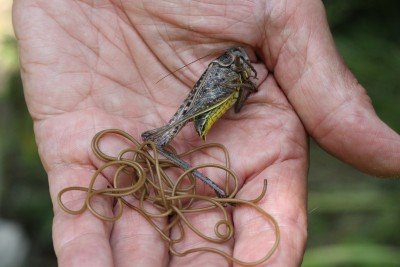
Let’s dig a little deeper into the lives of wolf worms and rodents. How do these worms survive inside their furry hosts? What’s their journey like from the moment they enter a rodent until they make their grand exit? It might sound a bit gruesome at first, but understanding this relationship can give us surprising insights into the ecosystem and the intricate web of life.
What Are Wolf Worms?
Wolf worms are actually the larval stage of the **botfly**. These fascinating creatures are known for their peculiar method of reproduction. The adult female botfly lays its eggs on a host, commonly a rodent like a mouse or a rat. Once the eggs hatch, the tiny larvae burrow into the skin of their host. They latch on, living off the host’s nutrients and developing inside.
You might be wondering why they’re called “wolf worms.” The term comes from their ability to infect larger hosts, much like wolves hunt for prey. While the idea of a little worm taking up residence in a rodent might bring some shivers, it’s a natural part of their life cycle. Think of it as an extreme form of partnership, purely driven by the quest for survival.
How Do Wolf Worms Survive Inside Rodents?
Inside a rodent, wolf worms have a cozy little setup. They don’t just float around; they attach themselves to the host’s tissues. This anchors them securely as they feed and grow. It’s as if they’ve found the ultimate survival hack. The warmth and nutrients from the rodent are critical for their development.
The way they feed is actually quite fascinating. Wolf worms have a unique structure that allows them to penetrate the host’s skin and tap into the bloodstream. This connection means they can access nutrients directly, keeping them healthy and happy during their growth phase. If you think about it, it’s like having an all-you-can-eat buffet right at their doorstep—no effort required!
The Life Cycle of Wolf Worms
The life cycle of wolf worms is a bit of a nail-biter. Once they’re inside their cozy host, they go through several stages of development over a few weeks. Initially, they’re tiny, almost microscopic, but this changes quickly. They grow larger, sometimes reaching lengths of several centimeters.
After about six to eight weeks, it’s showtime! The wolf worms have matured and are ready to emerge. They create a small exit hole in the rodent’s skin, which can be alarming for the host. It’s like a horror movie moment where the unexpected happens. Once they emerge, they drop to the ground, where they’ll enter their next phase as pupae and eventually become adult botflies.
It’s a wild transformation, and you might find it hard to believe that such a gruesome act is a natural part of their life cycle. But that’s nature for you—fascinating, complex, and sometimes a bit creepy.
What Happens After Emergence?
After wolf worms have exited their rodent hosts, they hit the ground running. This is their chance to finish their life cycle and find a mate. Once they become adult botflies, they have only one goal: to reproduce. The adults have a very short lifespan, typically just a few weeks, during which they must find a mate and lay eggs.
Interestingly, adult botflies don’t have the same gruesome eating habits as their larvae. They don’t actually feed on rodents; instead, they typically feed on nectar. This transition highlights the adaptability of these insects. They manage to survive through various life stages, each with its own unique needs and methods of survival.
After laying their eggs, the cycle starts all over again. It’s almost like a never-ending loop of life in the wild, reminding us that every creature plays a part in the bigger picture.
The Role of Wolf Worms in the Ecosystem
While wolf worms might sound scary, they play an important role in the ecosystem. By feeding on rodents, they help manage rodent populations. In turn, this helps prevent overpopulation, which can be harmful to the environment. Every animal, even the ones that give us the creeps, is part of a delicate balance.
Their presence also helps support food chains. As wolf worms emerge and become adult botflies, they provide food for other creatures. Birds, for instance, may feed on the adult botflies, which helps sustain local wildlife populations.
So, even though they might send a chill down your spine, wolf worms are crucial players in their ecosystems, showing us how interconnected life truly is.
Can Wolf Worms Affect Humans or Other Animals?
You might be wondering if wolf worms can pose a threat to humans or pets. While these larvae primarily target rodents, there is a possibility of them affecting other animals. In rare cases, they can infest larger mammals, including dogs and cats, but human infestations are extremely uncommon.
When this happens, it often leads to discomfort and potential health risks for the affected animal. If you suspect a pet might have an infestation, it’s essential to consult with a veterinarian. They can provide proper diagnosis and treatment, ensuring that your furry friend stays healthy.
In general, being aware of the life cycle of wolf worms can help us appreciate the circle of life and our place within it. It’s a great reminder that even the tiniest creatures have an important part to play in the grand tapestry of nature.
The story of wolf worms in rodents is a captivating journey through survival, adaptation, and the intricate relationships within ecosystems. From their unique life cycle to their role in managing populations, these little parasites highlight nature’s complexity and resilience.
So, next time you hear about wolf worms, remember they’re more than just creepy crawlies. They’re part of a fascinating process that teaches us about life, death, and everything in between. Nature is full of surprises, and every creature, no matter how small, plays a vital role. Let’s embrace the wonders of our world, knowing that each part contributes to a beautifully balanced ecosystem.
